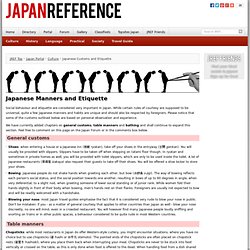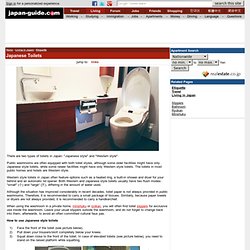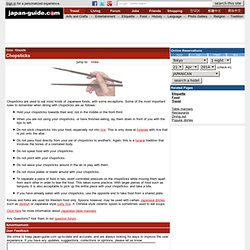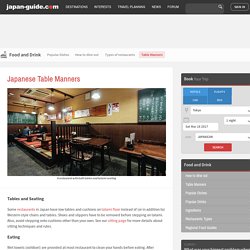

Japan's Etiquette. As of July 1, 2013 ThinkQuest has been discontinued.

We would like to thank everyone for being a part of the ThinkQuest global community: Students - For your limitless creativity and innovation, which inspires us all. Teachers - For your passion in guiding students on their quest. Partners - For your unwavering support and evangelism. Parents - For supporting the use of technology not only as an instrument of learning, but as a means of creating knowledge. We encourage everyone to continue to “Think, Create and Collaborate,” unleashing the power of technology to teach, share, and inspire. Best wishes, The Oracle Education Foundation. Japanese Customs & Etiquette - Japan Portal. Social behaviour and etiquette are considered very important in Japan.

While certain rules of courtesy are supposed to be universal, quite a few Japanese manners and habits are unique and should also be respected by foreigners. Please notice that some of the customs outlined below are based on personal observation and experience. We have currently added chapters on general customs, table manners and bathing and shall continue to expand this section. Feel free to comment on this page on the Japan Forum or in the comments box below. General customs Shoes: when entering a house or a Japanese inn (旅館 ryokan), take off your shoes in the entryway (玄関 genkan).
Japanese Etiquette: How to Save Yourself from Embarrassment in Japan. Did you know that it is extremely rude to rub your chopsticks together?

If you’ve ever considered a trip to the land of the rising sun you’ve probably done some research on proper Japanese etiquette. Many daily customs are significantly different from those of the western world. Hopefully this compiled list of proper manners will be all you’ll ever need to survive your stay in Japan. Check out these etiquette resources and never again bring shame and dishonor to your family. Table Manners Because eating is hard. Did you know that pouring soy sauce on your white rice is considered bad manners? In the House Because not wearing shoes is hard.
Japan - Language, Culture, Customs and Etiquette. Welcome to our guide to Japan.

This is useful for anyone researching Japanese culture, customs, manners, etiquette, values and wanting to understand the people better. You may be going to Japan on business, for a visit or even hosting Japanese colleagues or clients in your own country. Remember this is only a very basic level introduction and is not meant to stereotype all Japanese people you may meet! Facts and Statistics Location: Eastern Asia, island chain between the North Pacific Ocean and the Sea of Japan/East Sea, east of the Korean Peninsula. Capital: Tokyo Population: 127,333,002 (July 2004 est.) Ethnic Make-up: Japanese 99%, others 1% (Korean 511,262, Chinese 244,241, Brazilian 182,232, Filipino 89,851, other 237,914) Religions: observe both Shinto and Buddhist 84%, other 16% (including Christian 0.7%) The Japanese Language Japanese is the sixth most spoken language in the world, with over 99% percent of the country's population using it.
Doing Business in Japan. Japanese Toilets. There are two types of toilets in Japan: "Japanese style" and "Western style".

Public washrooms are often equipped with both toilet styles, although some older facilities might have only Japanese style toilets, while some newer facilities might have only Western style toilets. The toilets in most public homes and hotels are Western style. Western style toilets in Japan often feature options such as a heated ring, a built-in shower and dryer for your behind and an automatic lid opener. Both Western and Japanese style toilets usually have two flush modes: "small" (小) and "large" (大), differing in the amount of water used. Although the situation has improved considerably in recent decades, toilet paper is not always provided in public washrooms.
When using the washroom in a private home, minshuku or ryokan, you will often find toilet slippers for exclusive use inside the washroom. Eating at a Japanese restaurant. Show window displaying food replicas Japan has a large selection of restaurants of an almost endless variety.

While every place is different, the following points will help make dining out in Japan a smooth and enjoyable experience. Entering the Restaurant Many restaurants in Japan display plastic or wax replicas of their dishes in a window near their entrance. These replicas serve both to entice and inform patrons of the restaurant's menu and tend to offer an accurate, visual description of the style and price of meals found inside. Upon entering a restaurant, customers are greeted with the expression "irasshaimase" meaning "welcome, please come in". Chopsticks. Chopsticks are used to eat most kinds of Japanese foods, with some exceptions.

Some of the most important rules to remember when dining with chopsticks are as follows: Hold your chopsticks towards their end, not in the middle or the front third. When you are not using your chopsticks, or have finished eating, lay them down in front of you with the tips to left. Do not stick chopsticks into your food, especially not into rice. This is only done at funerals with rice that is put onto the altar.
Knives and forks are used for Western food only. Click here for more information about Japanese table manners. Japanese Table Manners. Tables and Seating Some restaurants in Japan have low tables and cushions on tatami floor instead of (or in addition to) Western style chairs and tables.

Shoes and slippers have to be removed before stepping on tatami. Also, avoid stepping onto cushions other than your own. See our sitting page for more details about sitting techniques and rules. Eating Wet towels (oshibori) are provided at most restaurant to clean your hands before eating. When eating from small bowls, it is correct manner to pick up the bowl with your hand and lead it close to your mouth when eating from it; however, larger types of dishes should generally not be picked up.